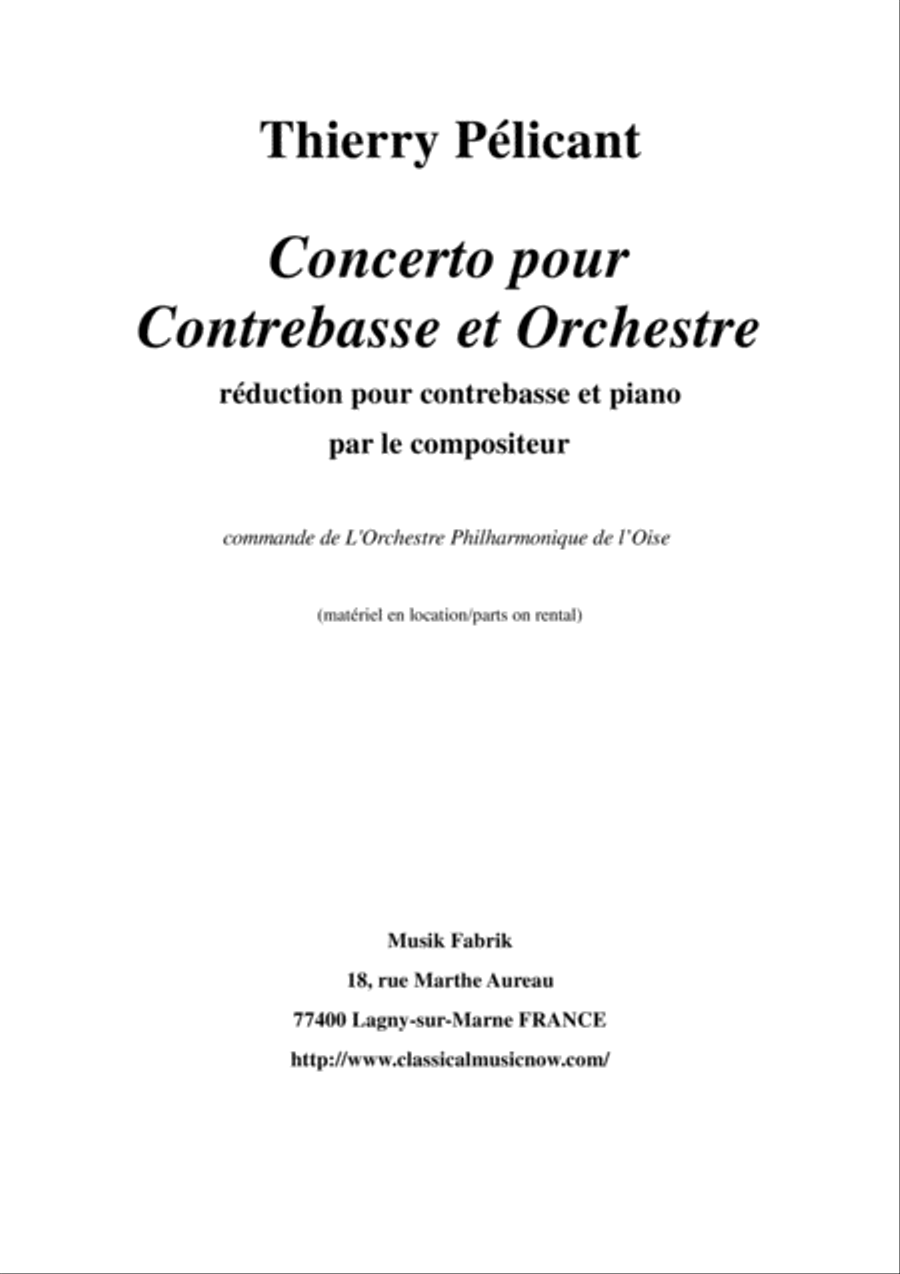Full Orchestra - Level 5 - Digital Download SKU: A0.534555 Composed by Thierry Pélicant. 20th Century,Contemporary,Standards. Score and parts. 46 pages. Musik Fabrik Music Publishing #4283543. Published by Musik Fabrik Music Publishing (A0.534555). In 2004, the Orchestre Philharmonique de lâOise commissioned its musical director, t Thierry Pélicant, this concerto for the late Claude Caens, the principal contrabass of this orchestra. This great artist, who was friends with everyone in this ensemble, wanted everyone to have a part in the festivities, not only the strings, but also the winds, the horns, the trumpets and the percussion, and also that they all should be heard ! Thierry Pélicant wrote therefore a concerto which is at once very symphonic â and for this reason, it is strongly advised that the contrabass be amplified â but also a piece which would express the friendship between the orchestra and the soloist. This concerto strives to be both warm and lyrical : it is not a virtuoso showpiece, inspite of the real technical that it offers to the soloist and which he would do well to try to hid them from the audience. It is also not a battle between the orchestra and this gentle giant : they stroll together, sometimes joyously, sometimes with nostalgia and go through the strong storms which do not fail to present themselves, smiling together and finding them to be envigorating.The work is scored for (2(Pic)2(EH)22/2200/Timp/2perc/strings) and lasts aproximately 23 minutes. The orchestral parts are on rental from the pubilsher. The full score is available for sale on this site.Thierry Pélicant was born in 1957 at Sainte-Adresse, France. After studying the organ and the horn, his meeting with Jean-Claude Hartemann, the Musical Director of the Opéra Comique in Paris lead him to decide to explore conducting. He was the student of Haremann for fifteen years. He is the Musical Director of the André Messager Orchestre and has also directed the Orchestre Philharmonique de lâOise since 1980, one of the oldest French orchestras, since it was founded in 1750. A passionate ssupporter of French music, Pélicant reconstructed the Messe solennelle of L.V.A Boïeldieu and Te Deum of 1792 by Philidor and premièred and recorded the Suite Parnassienne, Massenetâs last work. At the same time, he has also served the music of our time in premièring or recording the works of Dazzi, Marchand, Braconnier, Bénard, Drouin, Preschez, etc. As a composer, musical grammar and stylistic debates only interest him from afar. As a true gourmet (since cooking is another of his passions), he strives to write the music that pleases him, that would be enjoyable to play and which would be enjoyable to hear, hopefully with real pleasure and in which he tries to express the emotions and the pleasant or surprising states of being which, to hime, these works are tied. Through this process, he has created concertos (for oboe, for bassoon, for organ, for contrabass), Escales & paysages, ma monumental literary concerto for narrator, piano and orchestra, written for his friend Dominique Preschez, Operas (Histoires comme ça, Ribouldingue, Ãlise et le fantôme) ; With the poet Luis Porquet, he wrote the song cycle Ombre légère (for soprano, harp and orchestre), Rhapsodie du Havre (for tenor and chamber orchestra, a commission from the Forum de Normandie to commemorate the 500 years of the founding of the city Le Havre), Et de toi, Bethleem, Christmas oratorio for baritone, chorus and orchestra and, finally, commissioned by the Orchestre de lâOise in honor of the centennial of the First World War 14, fresque de la Grande Guerre, for the tenor Daniel Gà lvez-Vallejo, childrenâs chorus and orchestra. In the area of chamber music, he has written a sonata for horn and piano, for the Festival de Giverny, Borée (quintet for oboe and strings), Sextuor dâété, and Milonga (septet inspired by the World of Tango Music). Published in 2005, his novel Carnets de Walter Crane, explores the sufferings of a composer who has the obligation to write a string quartet ...
